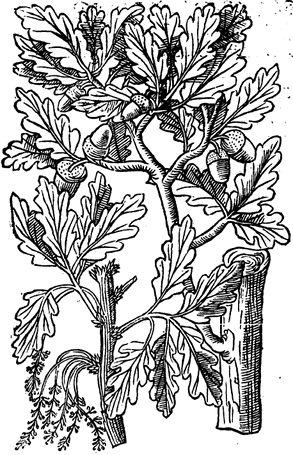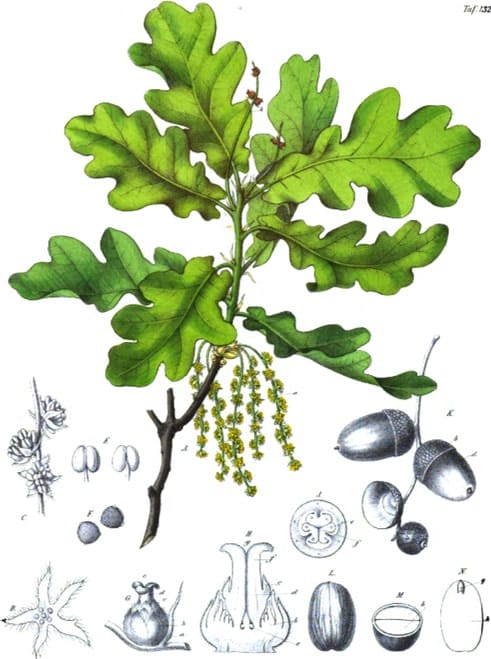Quercus, the Oak
Mon cha ra མོན་ཆ་ར (Tibetan) Parkinson, Theatrum Botanicum, 1640
Parkinson, Theatrum Botanicum, 1640 Atlas der officinellen pflanzen, Felix, 1899
Atlas der officinellen pflanzen, Felix, 1899Botanical name:
Quercus spp.
Q. robur, Q. alba, and Q. petraea are currently listed as official
The Japanese use Q. dentata similarly
In Tibetan Medicine, Q. lanuginosa and Q. acutissima are used
Parts used:
Bark; Leaf; Acorns and their Cups
Oak was also the preferred source for Polypody and Mistletoe
Temperature & Taste:
Cool, dry.
Classifications:
2N. REPELLENT. 2O. ASTRINGENT. 2S. STRENGTHENING. 2T. GLUTINATE
3F. LITHONTRIPTIC
Uses:
1. Stops Leakages and Bleeding:
-chronic Diarrhea and Dysentery
-Leukorrhea (for which it is used locally as a wash)
-Seminal Emission, Spermatorrhea.
-Incontinence; Acorns cups have been used for Diabetes (Bark, Acorns, Acorn cups)
-Spitting of Blood, Uterine Bleeding
-Night Sweats
-In Asia the bark of local varieties are used for Functional Bleeding, Leukorrhea, Prolapse of the Rectum, and Bloody Dysentery
-in Tibetan Medicine, the bark or acorns are used for Hot and Cold types of Diarrhea
2. Promotes Urine, Clears Stones:
-the inner Bark increases urine
-Stones of the Gall bladder and Urinary system
–Japanese have used the leaves of Q. salicina and others for Stones of the Bladder and Gall Bladder.
-Powdered Acorns have also been used as a Diuretic;
-the salts obtained from the leaves were also used to promote Urine, and clear Stones
3. Clears Heat, Resists Poison:
–‘Good against all Venom and Poison’ (Acorns; Gerard)
–the wood can be used the same as Guaiacum. (Salmon)
-Acorns and Bark resists Poisonous medicines
-Also used for intermittent Fevers
-Scrofula, Goiter (Bark; European & Japanese)
4. Tonic:
-bark has also been used in Europe for Tiredness, Fatigue, or Overexertion.
-Acorn ‘coffee’ has been used to strengthen the Bones, for Rickets in children, and for poor Bone development
5. Externally:
-to stop bleeding of the Gums, or bleeding Piles, and to heal Ulcers
–If a woman sits over the hot decoction, it is good for prolapsed Uterus;
-as a gargle for Toothache
Dose:
Oak Leaf and Oak bark are used similarly in similar doses.
Oak bark in Powder: 1–3 grams
Oak bark in Decoction: 2–6 grams (up to 9 grams)
Saturated tincture of Acorns: 20–30 drops
Strong decoction can be used externally as a wash.
Substitute:
The European Oaks can be used in place of the Tibetan species.
Main Combinations:
Astringent, Stop Leakage:
1. Diarrhea, chronic Dysentery:
i. Elm bark, Oak bark, Tormentil
ii. Diarrhea, chronic Dysentery: Conserve of Rosehip (6 oz.), Acorn powder (3 oz.), Red Coral prepared, Catechu (1 ½ oz.), Cinnamon (3 drams), Syrup of Red Rose (sufficient). Mix. Dose: 1 dram every 4 hours. (Formulaire de Montpellier, 1822)
2. Incontinence and Diabetes:
i. Acorns, Frankincense, Coriander seed, Armenian Earth, Gum Arabic (Wirtzung)
ii. Electuary for Diabetes: Acorn, Troches of Spodium, Rose seed, Purslane seed, Quince pulp
iii. Diabetes, peeled Acorn, Sweet Almonds (6 of each), Infusion of Mullein (6 oz.), Syrup of Ground Ivy (1 oz.). Mix. Take every evening. (Formulaire de Montpellier, 1822)
3. Enuresis:
i. Oak bark, Bearberry, Linden flower, St. Johns wort (Kroeber)
ii. Oak bark, Camomile, Uva Ursi, St. Johns wort, Agrimony, Tormentil, Catechu (Peyer)
4. Fever, Oak leaf water, Plantain water, Rose water
Other:
5. Stomach Ulcers, Oak bark, Calendula, Fumitory, Vervain, Veronica (Zimmerman)
6. Spitting Blood, Oak leaf, Scabious, Rose (Herbarium Horstianum, 1630)
7. Scrofula, Oak bark, Yellow Dock
8. Herpes, Ringworm, Eczema, Acorn cups, Willow leaf, Blackberry leaf, Plantain
9. Rashes, Oak bark, Horsetail, Camomile, Mallow, Thyme, Tormentil
Externally:
10. Shingles:
i. combine Oak bark with Camomile, Ladies Mantle and Sage
ii. Oak bark with Lady’s Mantle, Meliot, Oats, Camomile, decocted in water and used as a wash. (Treben)
11. Old sores, make a strong wash of Oak bark, Sage and Alum
12. Gonorrhea: Oak bark or leaf (1 or 2 oz.), Water (1 ½ lbs.). Boil to one pound. Injected into the urethra 3 or 4 times daily in obstinate chronic gonorrhea. (Pharmacopoeia medici practici universalis, Bruxelles, 1817)
13. Prolapse, Oak leaf with Comfrey, Madder, Sage, Pennyroyal, Cumin, Alum (as in Astringent Strengthening Decoction)
14. Douche for vaginal discharge, leukorrhea:
i. Oak bark with Birch leaf, Sage, Plantain leaf
ii. Oak bark with Nettle, Knotgrass and Camomile (Dinand)
iii. Oak bark with Rosemary, Sage, Yarrow (Meyer)
15. Suppository:
i. Oak bark, Tormentil (1 part each), Honey (2 parts). Mix. (Formulaire Magistral et Memorial Pharmaceutique, 1823)
16. Astringent Fomentation:
i. Oak bark (1 oz.), Water (sufficient to obtain 1 ½ lbs. of strained decoction).
ii. Oak bark (half oz.), Water (3 lbs.) Boil to one half, add Camomile (1 oz.). Infuse for half an hour and add when strained Vinegar (4 oz.). Mix. (Pharmacopoeia extemporanea, Augustin, 1822)
iii. Yarrow (1 oz.), Avens root, Oak bark (half oz. each), Lime Water (24 oz.). Boil to 12 oz., add Alcohol (3 oz.). Mix (Pharmacopoeia extemporanea, Augustin, 1822)
iv. Cinquefoil root (1 oz.), Oak bark powder, Rose (6 drams each), Water (1 lb.). Boil, strain. (Ratier)
Major Formula:
Astringent Strengthening Decoction
Decoction for Wounds
Cautions:
Very drying and astringent. Not used in Constipation.
Main Preparations used:
Tincture of Oak Bark, Distilled Water of the Green leaves
1. Tincture of Oak Bark:
i. Oak bark in coarse powder (2 oz.), Alcohol (1 lb.). Digest and filter.
2. Distilled Water of Oak Leaf
Fresh Oak Leaf (1 part), Water (6 parts), Distil 3 parts.
Stop excess Menstrual bleeding, stops Hematuria, and Bleeding from Wounds.
Dose: 6 oz.
-
Extra Info
- History
‘Acorns, pounded with salted axle-grease, are curative of those indurations known as “cacoethe.” [foul or cancerous tumors] The acorn of the holm-oak, however, is the most powerful in its effects; and in all these trees the bark is still more efficacious, as well as the inner membrane which lies beneath it. A decoction of this last is good for coeliac affections; and it is applied topically in cases of dysentery, as well as the acorns, which are employed also for the treatment of stings inflicted by serpents, fluxes, and suppurations. The leaves, acorns, and bark, as well as a decoction prepared from them, are good as counter-poisons. A decoction of the bark, boiled in cows’ milk, is used topically for stings inflicted by serpents, and is administered in wine for dysentery. The holm-oak is possessed of similar properties’. (The Natural History of Pliny, trans. by Bostock and Riley, Vol. 5, 1856)
